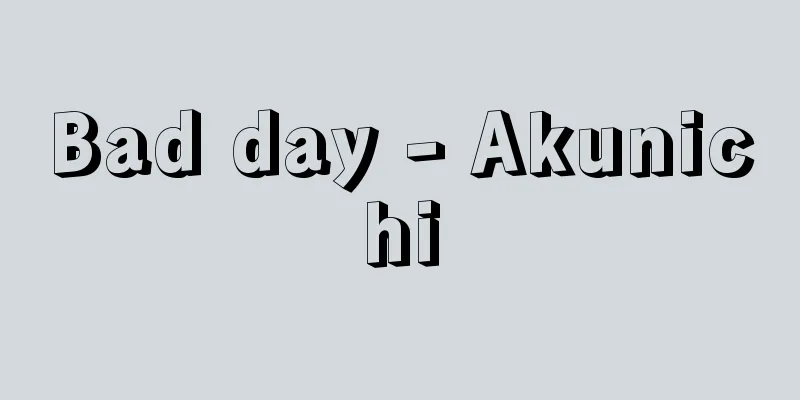Braille library - Tenji toshokan

|
A facility where braille publications and recordings for the visually impaired can be used. According to Article 34 of the Welfare Law for the Physically Disabled, it is positioned as an information facility for the hearing-visually impaired, and is set up by prefectures, municipalities, social welfare corporations, etc. It can be used free of charge or for a low fee. Since the Taisho era, braille books have been available for viewing and lending in some places, but the number of books held was small, about 200 to 300. In Japan, the braille library of Japan Lighthouse (now the social welfare corporation Japan Lighthouse), founded by Takeo Iwahashi (1898-1954) in 1935 (Showa 10), and the Japan Library for the Blind (now the Japan Braille Library) founded and operated by Kazuo Homma (1915-2003) in 1940 are well known as the representative braille libraries in Japan. In the early days, Braille libraries only had around 200-300 books in their collections, and the number of Braille books published was low, meaning that they had to be small. These issues were improved by the spread of Braille translation volunteer activities and the start of a publicly funded project to outsource the production and lending of Braille books to the private sector (1954). In particular, in 1957, the Ministry of Health and Welfare (now the Ministry of Health, Labour and Welfare) formulated a provisional draft standard for establishing Braille libraries and began to foster Braille libraries, which led to the establishment of Braille libraries all over the country. The number of braille libraries subsidized by the Ministry of Health, Labor and Welfare has been steadily increasing, from 10 in 1956 (Showa 31), to 26 in 1965, 41 in 1970, 63 in 1975, 70 in 1980, 74 in 1990 (Heisei 2), 74 in 1995, 73 in 2000, and 74 in 2007. There are also many braille libraries that are not subsidized, and they play a role as local facilities. Apart from Braille books, the spread of tape recorders has led to an increase in demand for audio books (books on tape). Since 1979, the Ministry of Health, Labour and Welfare has commissioned the Japan Braille Library and Japan Lighthouse to produce and lend audio books, and tape libraries have been established in Braille libraries across the country. Currently, public libraries also collect and lend audio books. In addition, with the increase in Braille and audio books, the National Diet Library has been compiling a comprehensive catalog of Braille and audio books nationwide since 1981 to facilitate the efficient mutual use of Braille and public libraries nationwide. [Masao Seo and Atsushi Suzuki] assignmentIt has been pointed out that visually impaired people are exposed to information barriers in our information society, and how Braille libraries can deal with this situation is an important issue. As the aging of society progresses, the number of people who have become visually impaired is increasing, and we are now in a situation where there are more users of audio books than Braille books. In order to meet the diverse needs of users, it will also be necessary to consider how Braille libraries can provide private services, and to strengthen cooperation between public libraries and Braille libraries. In any case, the role of Braille libraries as key stations of information for the visually impaired is expected to become increasingly important. In order to expand the functions of Braille libraries, it will be necessary to expand the scope of their services beyond Braille and audio books to include large-sized books for the visually impaired. Incidentally, Braille libraries in other countries, although their size and founders vary, primarily produce and provide large-sized books in addition to Braille and audio books. [Masao Seo and Atsushi Suzuki] "Japan's Braille Libraries <16> - Report on the 1997 Survey of Information Providers for the Visually Impaired Nationwide, compiled by the Service Committee of the National Association of Information Providers for the Visually Impaired (1999, National Association of Information Providers for the Visually Impaired)" ▽ "World Encyclopedia of the Blind, compiled by the Editorial Committee for the World Encyclopedia of the Blind (2004, Japan Book Distribution Center)" ▽ "Reading with Fingers and Ears - The Japan Braille Library and Me, by Kazuo Homma (Iwanami Shinsho)" [References] | | |Source: Shogakukan Encyclopedia Nipponica About Encyclopedia Nipponica Information | Legend |
|
点字刊行物および視覚障害者用の録音物を利用できる施設。身体障害者福祉法第34条により、視聴覚障害者情報提供施設に位置づけられ、都道府県、市町村、社会福祉法人等が設置する。無料または低額な料金で利用できる。大正時代から点字図書の閲覧や貸出しは一部で行われていたが、蔵書数は200~300冊程度の小規模なものであった。日本では、1935年(昭和10)に岩橋武夫(1898―1954)が創始した日本ライトハウス(現、社会福祉法人日本ライトハウス)による点字図書館、および1940年の本間一夫(1915―2003)による日本盲人図書館(現、日本点字図書館)の創設と活動が、日本を代表する点字図書館としてよく知られている。 草創期の点字図書館の蔵書数は200~300冊程度ともいわれているように、点字図書の出版が少なく小規模とならざるをえない状況下にあった。これらの改善に貢献したのが、点訳奉仕活動の普及と公費による点字図書の製作や貸出しの民間委託事業の開始(1954)であった。とくに1957年に厚生省(現、厚生労働省)が、点字図書館設置基準暫定案を策定して点字図書館の育成に乗り出したことにより、各地に点字図書館が設立されるようになった。 厚生労働省の補助対象の点字図書館数の推移は、1956年(昭和31)10館、1965年26館、1970年41館、1975年63館、1980年70館、1990年(平成2)74館、1995年74館、2000年73館、2007年74館となっており、定着してきている。これら補助対象以外の点字図書館も少なくなく、地域利用施設としての役割を果たしている。 点字図書とは別に、テープレコーダーの普及により録音図書(テープ図書)の需要が高まってきた。厚生労働省は1979年から日本点字図書館と日本ライトハウスに録音図書の製作と貸出しの委託事業を行い、全国の点字図書館にテープライブラリーが設けられるようになった。現在では、公立の図書館でも録音図書の蔵書や貸出しを行う。また、点字図書および録音図書の増加に伴い、全国の点字図書館や公立図書館の相互利用の効率化のため、国会図書館が全国の点字図書と録音図書の総合目録を1981年から作成している。 [瀬尾政雄・鈴木 篤] 課題情報化社会のなかで視覚障害者は情報障害にさらされているとも指摘されているが、このような状況に点字図書館はどのような対処が可能であるかが重要な課題である。高齢社会の進行とともに中途視覚障害者は増加しており、点字図書の利用者よりも録音図書の利用者のほうが多いという状況をきたしている。また利用者の多様なニーズにこたえるには点字図書館のプライベートサービスのあり方をどうするか、また公立図書館と点字図書館との連携の強化も今後はさらに必要となろう。 いずれにしても、視覚障害者の情報のキーステーションとしての点字図書館の役割はますます重要性を増すものと考えられる。点字図書館の機能の拡充のために、業務内容を点字図書と録音図書のみに限定せず、弱視者に対する拡大図書にまで広げることも必要であろう。ちなみに、外国の点字図書館では、規模や設置者の差はあるが、点字図書と録音図書に加えて拡大図書の製作・提供を主業務としている。 [瀬尾政雄・鈴木 篤] 『全国視覚障害者情報提供施設協会サービス委員会編『日本の点字図書館<16>――平成9年度全国視覚障害者情報提供施設実態調査報告』(1999・全国視覚障害者情報提供施設協会)』▽『世界盲人百科事典編集委員会編『世界盲人百科事典』(2004・日本図書流通センター)』▽『本間一夫著『指と耳で読む――日本点字図書館と私』(岩波新書)』 [参照項目] | | |出典 小学館 日本大百科全書(ニッポニカ)日本大百科全書(ニッポニカ)について 情報 | 凡例 |
<<: Electronic library - denshi toshokan (English) electronic library
>>: Electronic document - denshi document (English spelling) electronic document
Recommend
Golitsyn, AN (English spelling) GolitsynAN
…He was active in the Congress of Vienna, and adv...
Pierre Dolivier
1746‐1830 A theoretical spokesman for the popular ...
Alldeutscher Verband (English spelling) AlldeutscherVerband
...This emerged in two lines. One was a movement ...
Gresik (English spelling)
A port city in the state of Java Timur, eastern Ja...
quantum requirement of photosynthesis
…As a result of evolution based on bacterial phot...
Sthiramati
…He is one of the ten great scholars of the Yogac...
Antigone (English spelling)
…All of his early works portrayed the rebellion a...
Sayamidoro - Sayamidoro
A genus of minute, single-row filamentous green al...
Pe-Ce fiber
Chlorinated polyvinyl chloride fiber created by IG...
Book of Rites - Raiki
The name of a Confucian scripture. It is a compil...
Gattamelata - Gattamelata
...From the end of the 14th century to the 16th c...
Calbol - Carbole
...As a result, the price of carbolic acid rose b...
Enmeikaja - The Crown of Life
A Noh mask of a young man smiling with his eyes na...
Hydrophilic group - shinsui (English spelling)
This refers to the atomic groups in a molecule th...
Streptocarpus
A genus of the Gesneriaceae family found in Africa...








![Funo [village] - Funo](/upload/images/67ccb8cd35784.webp)
